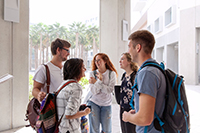Visit Dr. Christoper Bryan's Blog
A blog from Dr. Christopher Bryan was published by the Sheikh Saud bin Saqr Al Qasimi Foundation for Policy Research that discusses how teachers’ resilience can be supported in classrooms.


The COVID-19 pandemic has impacted education at all levels in various ways. Institutions and teachers had to quickly respond to an unexpected and ‘forced’ transition from face-to-face to remote teaching. In particular, expatriate teachers may be highly vulnerable to experiencing high levels of stress because of their specific situation. Insights into the demands that additional stressors may play in altering teachers’ likelihood of burnout are much needed to better support teachers transition into life back in the classroom post pandemic. The primary aim of this research is to investigate the variables effecting expatriate teachers’ stress delivering education during the COVID-19 pandemic in rural and urban settings in the UAE. The secondary research aim is to explore whether the added burden on expatriate teachers has “gone under the skin” after one year of disrupted education since the COVID-19 outbreak, that is, can be seen at a physiological level. Together, the research aims to identify risk and resilience factors that may help explain role that stressors may play in altering teachers’ effectiveness. By collecting survey data over two time points during the pandemic from 500 teaching staff in conjunction with physiological data from a subsample of 50 teachers in schools from Ras Al Khaimah and Dubai, the proposed research can provide important information about the resources that might help mitigate the possible negative effects of serious mental health problems, such as burnout in expatriate teachers. Together, the research has the potential to expand our knowledge on psychological and biological mechanisms of stress processes which could help explain future burnout implications within expatriate teachers post pandemic.
Selected Publications
Bryan, C., & von Suchodoletz, A. (2023). Teachers’ Resilience and Burnout in the United Arab Emirates: Teaching Through the COVID-19 Pandemic. Gulf Education and Social Policy Review (GESPR), 23-56.
A blog from Dr. Christopher Bryan was published by the Sheikh Saud bin Saqr Al Qasimi Foundation for Policy Research that discusses how teachers’ resilience can be supported in classrooms.
The purpose of this research is to investigate how young children and their parents living in the Emirate of Abu Dhabi are experiencing the current COVID-19 pandemic. Guiding our inquiry are research questions related to the impact of the pandemic on family well-being and psychological adaptation to the current context, especially as these relate to mental and physical health, education, social interactions, work, and time spent on electronic devices.
The project aims to (1) elucidate the effects of the professional development intervention (KiQ program) on teachers’ and preschool center directors’ interactions with children, parents, and teachers in their daily routines with a multi-informant, multi-assessment approach and to (2) provide valuable information for future research and practice with the KiQ program (i.e., ‘What module works when and for whom?’). Therefore, we will (1) test whether participation in the KiQ program leads to changes in the quality of educational dialogue in classrooms of teachers participating in the tandem modules. Addressing the question of potential dissemination of the pedagogical approach of learning through discovery and experience into the entire team of teachers in an institution, we also aim to (2) explore potential changes in the quality of educational dialogue in classrooms of teachers who do not participate in the tandem modules. Finally, we plan to (3) investigate factors that might facilitate or hinder KiQ program effects and dissemination applying an ambulatory assessment design. A central focus will be on preschool center directors because of their important role for the success of the implementation of pedagogical approaches in preschools.
The primary goal of the study is to understand role that stress response regulation plays in potentially promoting or inhibiting a teacher’s ability to provide positive teacher-child interactions. More specifically, the project aims to explore whether the hypothalamic-pituitary-adrenal (HPA) axis regulation relates to the quality of teacher-child interactions through its impact on teachers’ executive functioning. Moreover, it aims to explore similarities and differences in the patterns of associations across four different educational contexts. The second goal of the study is to investigate direct and indirect relations between teacher-child interactions and kindergarten students’ emerging academic outcomes.
For a subsample of teachers from the UAE and Finland, mobile eye-tracking glasses were used to measure teachers’ visual attention during classroom interactions. This part of the project aims to contribute to a new model of understanding the mechanisms underlying teacher professional vision, as barriers or facilitators, to high-quality instruction. The goal is (1) to explore teachers’ visual attention during classroom interactions and to link teachers’ eye gaze to key events in classroom interactions and students’ learning; and (2) to investigate the cultural nature of teachers’ visual attention and identify specific differences and similarities among patterns of visual attention in a sample of teachers from the United Arab Emirates and Finland.
Research Brief —Patterns of Dialogic Teaching (PDF)
Exploring parents’ eye gaze can shed light on how parents cognitively process key events in parent-child interactions. Such knowledge is essential for understanding the dynamics of social processes or interactions between a parent and the child. Eye movements are thought to provide an indicator of the focus of attention at any given moment. The project uses advanced mobile eye-tracking technology to measure parents’ eye gaze in real-time while they interact with their child. The goal of the project is to explore parents’ visual attention during three different everyday parenting situations (play, book-reading, receiving a gift) and link parents’ eye gaze to key events in parent-child interactions.
In recent years, intervention research identified program implementation as key aspect to gain insights into a program’s effectiveness. The project aims to have a careful look at the feasibility of assessment procedures in humanitarian and fragile settings. A major challenge is the development of sensitive and accurate yet culturally-appropriate measures. This might be particularly relevant for physiological measures that can provide proxies for underlying psychological processes, such as stress. Recent technological innovations make it possible to take classically lab-based physiological measures into real-life settings. Yet, most measures have been used thus far in predominately stable, economically developed contexts. Implementing physiological measures in humanitarian and fragile settings may involve cultural challenges regarding the measures’ applicability and feasibility. The goal of this project is (1) to test physiological measures in the study of caregiver-child interactions in humanitarian and fragile settings, and (2) to investigate caregiver-child synchrony (or asynchrony) as physiological covariation (i.e., the amount of correlation between caregiver’s and child’s physiology within a single time period that is believed to result from shared experiences or environments).
The project is aligned with a larger initiative at NYU’s Global TIES for Children, i.e., Sesame Seeds, a large-scale early childhood development program in humanitarian and fragile settings (PIs Drs. Hirokazu Yoshikawa and Alice Wuermli), to inform the implementation of the Sesame Seeds Home component. Sesame Seeds Home, a caregiving program delivered through home visits and mobile messages, targets the most high-risk families with children ages 8 and younger affected by the Syrian humanitarian crisis; a main goal is to reduce the impact of stress on the well-being of the family and to support caregivers in providing their children with a nurturing environment to help them reach their full developmental potential.
The project aims to investigate teachers’ cognitive and metacognitive processes throughout the process of science education in secondary schools in Abu Dhabi to ascertain in how far these processes are moderated or mediated by classroom heterogeneity and level of teachers’ expertise. Building on these findings we aim to conceptualize and pilot a training tailored to teachers’ and students’ needs to foster instructional quality in science education.
The goal of the study was to:
We selected children’s behavioral self-regulation and stress physiology because of their importance for children’s school readiness. Participants were 26 kindergarten teachers and, on average, five children per classroom (in total 115 five-years-old children).
The goal of the study was to:
Data was collected from over 1,700 10-18-years old students from private and public schools in Abu Dhabi. Students completed a survey to assess their self-reported learning- and health-related behaviors.
The objective of the study was to examine the relationship between different states of mind (mindsets) and academic achievement motivation.
The project aimed to test the effects of the deliberative and implemental mindset on goal commitment and goal attainment among college students. In addition to a sample of international students at NYUAD, data was also collected at Zayed University Abu Dhabi. The gender-segregated educational background at Zayed University Abu Dhabi provided a valuable angle since separate educational settings can change learning attitudes as well as behavior.
With these two data sets, we will be able to compare the results of two different systems and to explore if mindset effects have the same impact. Since mindset effects are supposed to be universal, this experiment may provide much-needed data on cultural applicability of the mindset theory.
If you have any questions, please email us at nyuad.tld-lab@nyu.edu.